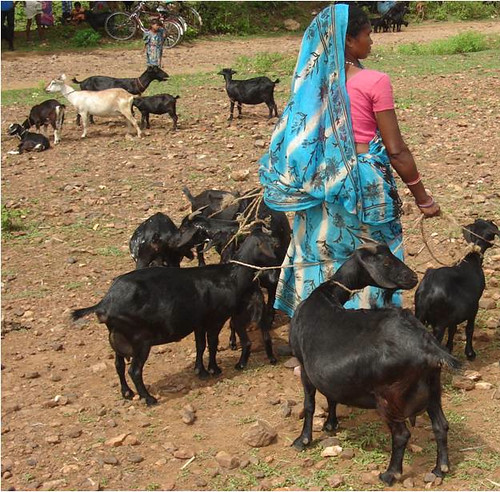
A woman in Jharkhand, in eastern India, tends her goats (photo credit: BAIF).
A new report from the International Livestock Research Institute (ILRI) highlights the potential for the livestock sector in the state of Jharkhand, in eastern India, to move millions of people out of poverty.
Jharkhand, formerly part of Bihar, was created as a new state in 2000. Despite having rich mineral resources and some of India’s most industrialized cities, its population of 27 million are amongst the poorest in India. Some 26% of the population is classified as ‘Scheduled Tribes’ and a further 12% as ‘Scheduled Castes’.
The rural economy is dominated by smallholder rain-fed farming and use of extensive common property resources. Nearly 56% of holdings are less than 1 hectare (2.5 acres) in size. Most farmers here raise livestock and grow rice, although pulses, maize, wheat and oil seeds are also grown. Lack of investment in infrastructure (only 9% of the sown area is irrigated), poor extension services, lack of input supplies and services as well as a lack of training have led to low agricultural yields and very low incomes.
The Sir Ratan Tata Trust, which has been funding rural livelihood programs in Jharkhand for several years, commissioned ILRI to undertake a study of the livestock sector to explore its potential for improving livelihoods in this state. As in the rest of India and other developing countries, the demand for livestock products in Jharkhand is increasing. With 90% of rural households in the state keeping livestock, there is a huge opportunity for these small and marginalized farmers to supply the growing livestock markets with livestock products. In areas around towns, the study found a booming demand for milk, much of which has been met by imports from neighbouring states, but peri-urban dairies are developing to supply the demand locally.
Dairying, however, is not an option for all. As Iain Wright, ILRI’s regional representative for Asia and one of the report’s authors, explains, ‘In the tribal societies, there is no tradition of milk consumption or of producing milk, so there are no traditional skills in dairy production. These communities do, however, have a long tradition of keeping goats and pigs. And with high goat meat and pork prices driven by growing demand, many rural communities, including those of “Scheduled Tribes” and “Castes”, have the potential to supply pork and goat meat for markets outside as well as within the state.’
Assessing the results of surveys carried out in different parts of the state, the authors of the report recommend the following ways to overcome the technical, institutional and policy constraints to livestock development, especially among poor and marginalized livestock keepers: (1) tailor development programs to suit different ethnic communities and locations and build on the traditional skills and knowledge of local communities, (2) help livestock producers to access markets and improve their marketing skills, and (3) implement community-based programs to support livestock development.
The report concludes that poor coordination among the key stakeholders in the livestock sector—from government officials to livestock researchers to staff of non-governmental organizations, banks, insurance companies and other financial institutions—is what is most hindering the development of the livestock sector. A main recommendation, therefore, is to establish a common platform, facilitated by the government, where key players can come together to exchange information and experiences and identify knowledge gaps.
ILRI will be implementing some of the recommendations of the report in two new projects in Jharkhand. An imGoats project will work to strengthen goat value chains in Mozambique and India, including Jharkhand, and as part of an ELKS Project, ILRI is supporting an organization called ‘Collectives for Integrated Livelihood Initiatives (CInI), which is supported by the Sir Rattan Tata Trust, in the design of a new project to improve the livelihoods of goat and pig keepers.
For further information, contact Iain Wright (i.wright@cgiar.org), the author of this blog post, or read the ILRI report by Rameswar Deka and Iain Wright: Potential for livelihood improvement through livestock development in Jharkhand, January 2011.
